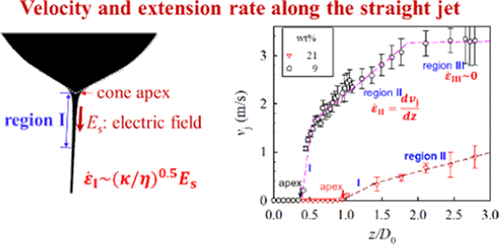当前位置:
X-MOL 学术
›
Macromolecules
›
论文详情
Our official English website, www.x-mol.net, welcomes your feedback! (Note: you will need to create a separate account there.)
Formation of Dissipative Structures in the Straight Segment of Electrospinning Jets
Macromolecules ( IF 5.5 ) Pub Date : 2020-09-09 , DOI: 10.1021/acs.macromol.0c01343 Chi Wang, Takeji Hashimoto, Yu Wang, Hsin-Yi Lai, Chih-Hsien Kuo
Macromolecules ( IF 5.5 ) Pub Date : 2020-09-09 , DOI: 10.1021/acs.macromol.0c01343 Chi Wang, Takeji Hashimoto, Yu Wang, Hsin-Yi Lai, Chih-Hsien Kuo

|
Accurate jet diameters have been experimentally obtained during electrospinning by the light-scattering technique together with the Mie theory for cylinder scattering. Afterward, the fluid velocity and extension rate in the jet from the apex of the flow-modified Taylor cone to the straight jet end prior to the jet whipping are feasibly derived. It is found that the extension rate ε̇ is position (or time) dependent; its magnitude is the highest at the apex (region I with ε̇I) and rapidly decreases to a relatively constant value in the main jet (region II with ε̇II) before reaching the jet end (region III), where the extension rate is zero. It is of importance to notice that ε̇I could be as high as 4000 s–1, which is much higher than the chain retraction rate τe–1 obtained from the rheological measurement. This experimentally measured ε̇I is consistent with that derived theoretically based on a simple energy conservation between the electric work and the drag flow energy, i.e., ε̇I = (κ/ηe)0.5Φ0.5Es, where κ is the solution conductivity, ηe is the elongational viscosity, Es is the electric field at the cone apex, and a parameter Φ to characterize the viscoelasticity of the flowing jet. Our analyses of the extension rate in the straight jet reveal the general trend of ε̇I > ε̇II > τe–1 > τd–1, suggesting likely a sequential structure evolution leading eventually to the strings within the jet due to, first, the flow-induced large concentration fluctuations in single phase solution (at τd–1 < ε̇ < ε̇inst. < τe–1) and, subsequently, phase separation (at ε̇inst. < ε̇ < τe–1) eventually leading to evolution of the strings with increasing ε̇ (at ε̇ > τe–1), where τd–1 is the chain disentanglement rate, and ε̇inst. is the critical stretching reate for onset of the flow-induced thermodynamically instability. To validate this hypothesis, we have developed a simple collecting method to receive the fast-flowing jet in a nonsolvent reservoir in an attempt to quickly freeze its internal structures developed, if any, for the off-line optical and electron microscopy observations. Based on the results obtained from six polymer solutions studied, the formation of dissipative structures of “strings” with various widths due to growth or ordering of phase-separated structures developed on a mesoscopic scale seems to be a general phenomenon. In situ observation of the straight jet by a high-speed camera is also performed to reveal the rapid flowing of dissipative structures of “bulges” developed by macroscopic phase separation in the jet. We conclude that the extremely high extension rate at the cone apex plays a dominant role in the subsequent structure evolution, generally producing the flow-induced phase-separated structures.
中文翻译:

静电纺丝直段中耗散结构的形成
在静电纺丝过程中,通过光散射技术以及圆柱散射的米氏理论,已经通过实验获得了准确的射流直径。此后,可以容易地推导出在射流搅动之前从流动改进的泰勒锥的顶点到笔直射流端的射流中的流体速度和延伸率。发现扩展速率ε̇是位置(或时间)相关的。它的大小是在顶点最高(区域I与ε-我),并迅速在主喷射下降到一个相对恒定的值(区域II与ε- II)在到达喷射端部(区域III),其中,所述延伸率为零之前。这是重要注意到的ε我可能高达4000小号-1,比该链回缩率τ高得多Ë -1从流变学测量获得。这个实验测得的ε&amp;我是与基于所述电动工作和拖曳流能量,即,ε之间的简单节能理论上导出一致我=(κ/η ë)0.5 Φ 0.5 ë小号,其中κ是溶液电导率,η Ë是伸长粘度,ê小号是在锥体顶点的电场,和一个参数Φ表征流动射流的粘弹性。我们对直射流中延伸率的分析揭示了ε̇的总体趋势我>ε&amp; II >τ é -1 >τ d -1,这表明可能是顺序结构演进最终导致由于射流中的字符串中,首先,在单相溶液中的流动引起大的浓度波动(在τ d - 1 <ε<ε研究所。 <τ Ë -1),并随后相分离(ε&amp;在研究所。 <ε<τ ë -1)最终导致串的演化随ε(在ε>τ ë -1),其中τ d -1为解缠结链速率,ε研究所。是引起流动引起的热力学不稳定的关键拉伸条件。为了验证这一假设,我们已经开发了一种简单的收集方法,可以在非溶剂储层中接收快速流动的射流,以试图快速冻结其内部结构(如果有的话),以便进行离线光学和电子显微镜观察。根据从六个研究的聚合物溶液中获得的结果,由于细观尺度上形成的相分离结构的生长或有序排列,形成具有不同宽度的“线”的耗散结构似乎是普遍现象。还通过高速相机在原位观察直射流,以揭示由宏观相分离在射流中形成的“凸起”的耗散结构的快速流动。
更新日期:2020-09-22
中文翻译:

静电纺丝直段中耗散结构的形成
在静电纺丝过程中,通过光散射技术以及圆柱散射的米氏理论,已经通过实验获得了准确的射流直径。此后,可以容易地推导出在射流搅动之前从流动改进的泰勒锥的顶点到笔直射流端的射流中的流体速度和延伸率。发现扩展速率ε̇是位置(或时间)相关的。它的大小是在顶点最高(区域I与ε-我),并迅速在主喷射下降到一个相对恒定的值(区域II与ε- II)在到达喷射端部(区域III),其中,所述延伸率为零之前。这是重要注意到的ε我可能高达4000小号-1,比该链回缩率τ高得多Ë -1从流变学测量获得。这个实验测得的ε&amp;我是与基于所述电动工作和拖曳流能量,即,ε之间的简单节能理论上导出一致我=(κ/η ë)0.5 Φ 0.5 ë小号,其中κ是溶液电导率,η Ë是伸长粘度,ê小号是在锥体顶点的电场,和一个参数Φ表征流动射流的粘弹性。我们对直射流中延伸率的分析揭示了ε̇的总体趋势我>ε&amp; II >τ é -1 >τ d -1,这表明可能是顺序结构演进最终导致由于射流中的字符串中,首先,在单相溶液中的流动引起大的浓度波动(在τ d - 1 <ε<ε研究所。 <τ Ë -1),并随后相分离(ε&amp;在研究所。 <ε<τ ë -1)最终导致串的演化随ε(在ε>τ ë -1),其中τ d -1为解缠结链速率,ε研究所。是引起流动引起的热力学不稳定的关键拉伸条件。为了验证这一假设,我们已经开发了一种简单的收集方法,可以在非溶剂储层中接收快速流动的射流,以试图快速冻结其内部结构(如果有的话),以便进行离线光学和电子显微镜观察。根据从六个研究的聚合物溶液中获得的结果,由于细观尺度上形成的相分离结构的生长或有序排列,形成具有不同宽度的“线”的耗散结构似乎是普遍现象。还通过高速相机在原位观察直射流,以揭示由宏观相分离在射流中形成的“凸起”的耗散结构的快速流动。



























 京公网安备 11010802027423号
京公网安备 11010802027423号